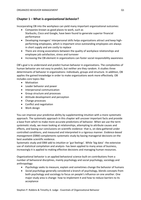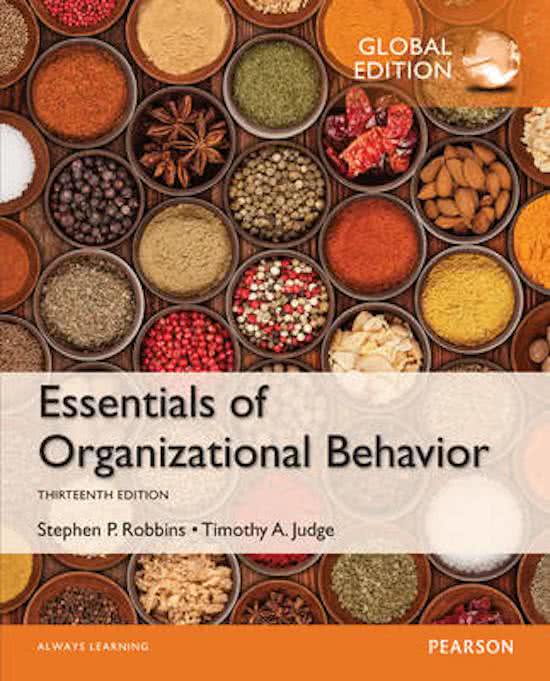ORGANIZED BEHAVIOR MANAGEMENT Q1
Chapter 1 – What is organizational behavior?
Incorporating OB into the workplace can yield many important organizational outcomes:
Companies known as good places to work, such as
Starbucks, Cisco and Google, have been found to generate superior financial
performance
Developing managers’ interpersonal skills helps organizations attract and keep high-
performing employees, which is important since outstanding employees are always
in short supply and are costly to replace
There are strong associations between the quality of workplace relationships and
employee job satisfaction, stress and turnover
Increasing the OB element in organizations can foster social responsibility awareness
OB’s goal is to understand and predict human behavior in organizations. The complexities of
human behavior are not easy to predict, but neither are they random. It studies three
determinants of behavior in organizations: individuals, groups and structure. In addition, OB
applies the gained knowledge in order to make organizations work more effectively. OB
includes core topics like:
Motivation
Leader behavior and power
Interpersonal communication
Group structure and processes
Attitude development and perception
Change processes
Conflict and negotiation
Work design
You can improve your predictive ability by supplementing intuition with a more systematic
approach. The systematic approach in this chapter will uncover important facts and provide
a base from which to make more accurate predictions of behavior. When we use the term
systematic study, we mean looking at relationships, attempting to attribute causes and
effects, and basing our conclusions on scientific evidence- that is, on data gathered under
controlled conditions, and measured and interpreted in a rigorous manner. Evidence-based
management (EBM) complements systematic study by basing managerial decisions on the
best available scientific evidence.
Systematic study and EBM add to intuition or ‘gut feelings’. While ‘big data’- the extensive
use of statistical compilation and analysis- has been applied to many areas of business,
increasingly it is applied to making effective decisions and managing human resources.
Organizational behavior is an applied behavioral science built on contributions from a
number of behavioral disciplines, mainly psychology and social psychology, sociology and
anthropology:
Psychology seeks to measure, explain and sometimes change the behavior of humans
Social psychology generally considered a branch of psychology, blends concepts from
both psychology and sociology to focus on people’s influence on one another. One
major study area is change- how to implement it and how to reduce barriers to its
acceptance
Stephen P. Robbins & Timothy A. Judge - Essentials of Organizational Behavior
,ORGANIZED BEHAVIOR MANAGEMENT Q1
Sociology studies people in relation to their social environment or culture
Anthropology is the study of societies to learn about human begins and their
activities
Human beings are complex, and few, if any,
simple and universal principles explain
organizational behavior. Because we are not
alike, our ability to make simple generalizations is
limited. This means that OB concepts must reflect
situational, or contingency, conditions. We can
say x leads to y, but only under the conditions
specified in z- the contingency variables.
Today’s challenges bring opportunities for
managers to use organizational behavior
concepts. There are a few critical issues
confronting managers for which organizational
behavior offers solutions- or at least meaningful
insights toward solutions:
Responding to Economic Pressures in good times, understanding how to reward,
satisfy and retain employees is at a premium. In bad times, issues like stress, decision
making and coping come to the fore.
Responding to Globalization increased foreign assignments, working with people
from different cultures, overseeing movement of jobs to countries with low-cost
labor and adapting to different cultural and regulatory norms
Managing workforce diversity diversity presents great opportunities and poses
challenging questions for managers and employees in all countries
Improving customer service how do employee attitudes and behavior influence
customer satisfaction
Improving people skills motivation etc.
Working in Networked Organizations motivating and leading people and making
collaborative decisions online require different techniques than when individuals are
physically present in a single location
Enhancing employee well-being at work
Creating a positive work environment
Improving ethical behavior
Stephen P. Robbins & Timothy A. Judge - Essentials of Organizational Behavior
, ORGANIZED BEHAVIOR MANAGEMENT Q1
Chapter 2 – Workplace diversity
Diversity in society and organizations is complex. Managers sometimes forget they need to
recognize and capitalize on differences to get the most from their employees. Effective
diversity management increases an organization’s access to the widest possible pool of skills,
abilities and ideas. While diversity can be an asset, managers also need to recognize that
differences among people can lead to miscommunication, misunderstanding and conflict.
The two main levels of diversity that Robbins describes are surface-level diversity and deep-
level diversity. Surface-level diversity are demographic characteristics such as age, gender,
race and religion. Deep-level diversity are differences you can’t see on the outside of people,
for example personality and values, you can only become aware of these differences is you
get know certain people.
What we usually mean when we talk about
workforce discrimination is, for example,
when someone is not promoted or doesn’t
get a job because of their gender, race or
religion. The person in charge is influenced
by stereotypes about groups or people.
Rather than looking at individual
characteristics, unfair discrimination
assumes everyone in a group is the same.
A few different levels of discriminatory
actions taken by representatives of the
organization are sexual harassment,
intimidation, mockery and insults, exclusion and incivility. Exclusion and incivility are hard to
root out because they are difficult to observe. Mockery and insults can happen at an
organization when an Arab-American person has been asked if he or she was carrying a
bomb or was a member of a terrorist organization. Intimidation can occur when an Afro-
American employees have found nooses hanging over their work stations.
Biographical characteristics that are potential sources for discrimination are:
Age The older you get, the less likely you are to quit your job. Older workers do
not have more psychological problems or day-to-day physical health problems that
younger workers. Reviews of the research find that age and job task performance are
unrelated and that older workers are more likely to engage un organization helping
behavior. The evidence for the relationship between age and job satisfaction is
mixed. More than 800 studies found that older workers rend to be more satisfied
with their work and colleagues, other studies have found a U-shaped relationship
meaning that job satisfaction increases up to middle age, at which point it begins to
drop off. It may well be that the relationship is complex and depends on job type.
Sex Women scored slightly higher than men on performance measures. There are
no consistent male-female differences in problem-solving ability, analytical skills,
competitive drive, motivation, sociability or learning ability. Notably women still earn
less money than men for the same positions.
Stephen P. Robbins & Timothy A. Judge - Essentials of Organizational Behavior






